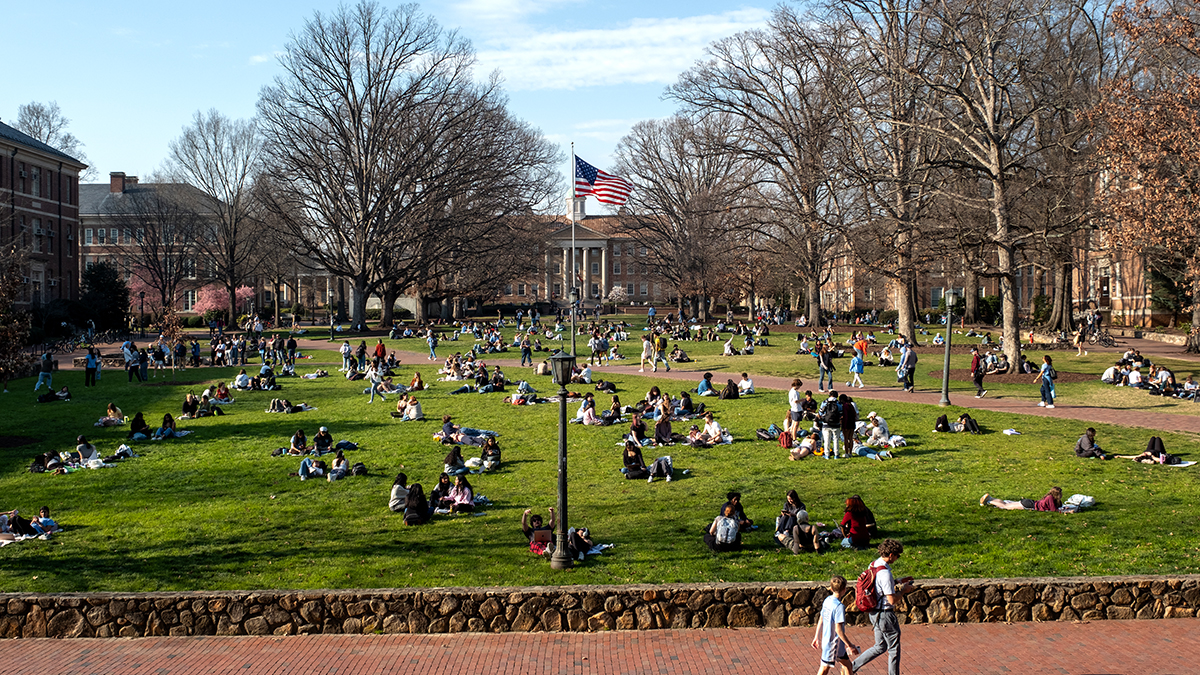We’re still here: Keeping Carolina beautiful
Throughout the pandemic, Grounds Services workers stayed on the job to make sure the outdoor areas of historic campus remained clean and picturesque. A year later, they’re still at it.
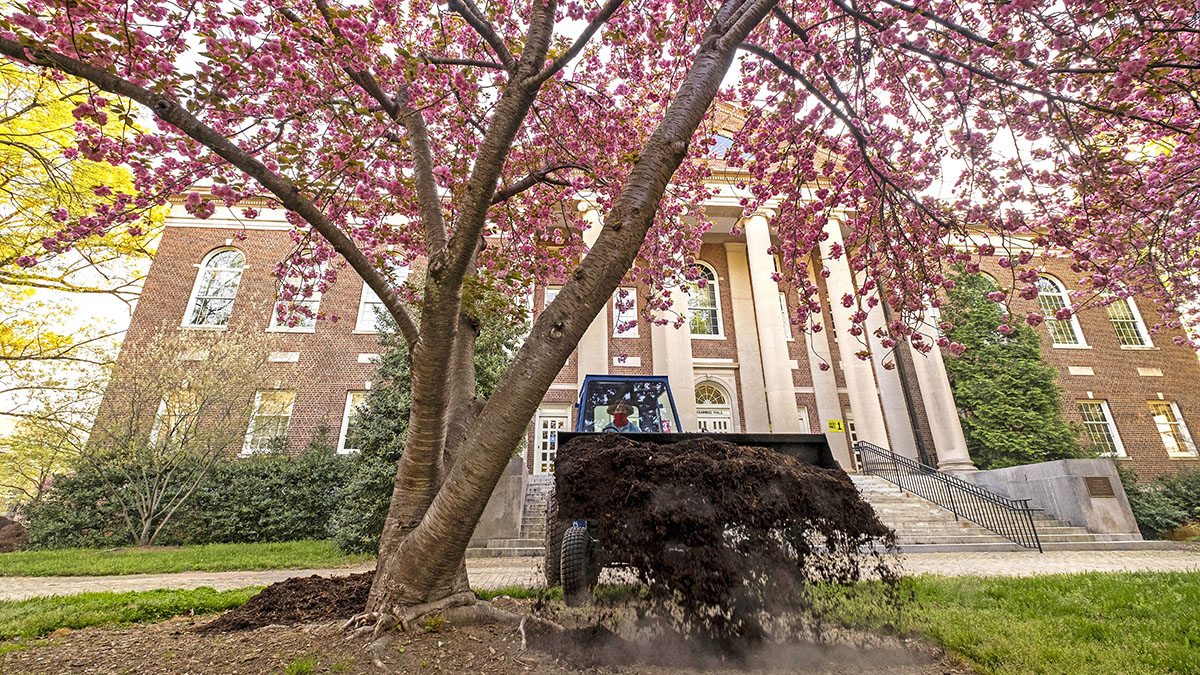
7 a.m., March 20, 2020, near the Campus Y.
A breeze rustling the willow branches overhead hinted at the day’s forecast of an unseasonably high 81 degrees. Two Grounds Services crews that keep up what they call the historic campus gathered to plan a day’s work that would set the stage for springtime blooms and shades of green.
Instead, Grounds Supervisor Peter Ampuja told the 11 men and women that due to the pandemic the University was asking workers in crews across campus to voluntarily stay home because of underlying health concerns or for the safety of their family.
That left only three people to keep Carolina’s most visible areas, 81 acres to be exact, beautiful and litter-free. Over the next three months, they experienced a campus like no other in its modern history.
General Utility Worker Ryan Talley, Grounds Worker Eric Tolar and Ampuja from the Historic Campus crew were soon joined by Building and Environmental Services Technician Krystal King from another crew. Tolar worked mostly in McCorkle Place. King kept up a swath they refer to as “Old Well” along Cameron Avenue from Coker Arboretum to Swain Hall. Talley’s territory began at the Naval Armory on Columbia St. through Polk Place to behind Davis Library.
That’s about 61 football fields filled with trees, shrubs, plants, flowers, grass, weeds and pathways that require pruning, fertilizing, mulching, watering, insect and disease control, planting, and debris and litter removal. On rainy days they serviced their equipment, machines and utility vehicles.
“At the beginning, it was creepy,” Talley said. “Normally there would be thousands of people walking through my zone every hour. It went from that to maybe a dozen — people working, locals walking dogs or employees headed to research labs.”
Normally, Ground Services workers from Facilities Services in the Division of Finance and Operations would be out on campus. Instead, the four met each morning near the Campus Y to plan their day, then hit their to-do lists. They kept in touch during a time when there was little contact with anyone. “It was all new to us, and we’d check in or text with each other to ask, How are you feeling, how are you doing?” Ampuja said. They usually ate lunch, socially distanced, at picnic tables.
“Our staff was temporarily reduced by about 70%, but it was still great to be able to work,” Ampuja said. “When people were sent home, we were in the middle of fertilizing and seeding. The grass and flowers and shrubs all continued to grow. Nature’s going to take over if we don’t step in, so there’s been plenty to do, and those were fast eight-hour days.”
“When it started, I felt like I needed to stay safe and stay away from people,” King said. “Without all of our people, it was a bit overwhelming at times to make all of this look good,” she said, waving her hand toward the Old Well.
After restrictions lightened a bit and the weather turned nice, Talley said that 100 to 200 people would eat lunch on campus. “They went to Franklin Street for food, then ate outside on the grass. It was a transition of going from nobody to almost normal,” he said.
“The trickiest part was that for quite a while we didn’t know when we could begin adding back people,” Ampuja said.
Help arrived in June, when the first of their co-workers returned to campus. By early August, everyone was back on the job.
Ampuja said that the crew stepped up their game, trusting each other and adhering to the three Ws. “We avoided stores and getting haircuts,” he said. “We have to go home to families, so we watched out for each other.”
“It was definitely concerning,” Talley said. “My biggest thing was wondering how easily the virus could reach Chapel Hill.
“We did a great job. Krystal and Eric really held down their zones. There were no expectations. We went from 12 people to four, and we did a hell of a job. We gave Chapel Hill a place to come and get away from the coronavirus as much as you could. Campus is gorgeous in April and May, so it’s a shame not everyone got to see it.”
Groundskeeping by the numbers
60 trash cans
total number the crew empties every day at 6 a.m. and again at 1 p.m., going from McCorkle Place through Polk Place and the Pit.
81 acres
total work area — around the size of 61 football fields — covered by the Historic Campus crew.
120 cubic yards
volume of mulch spread by the crew on 20 acres of campus, equivalent to 1,620 two-cubic foot bags sold by garden stores.
20 acres
area of turf to mow, with Polk Place sometimes taking 12 hours of precise cutting and trimming.
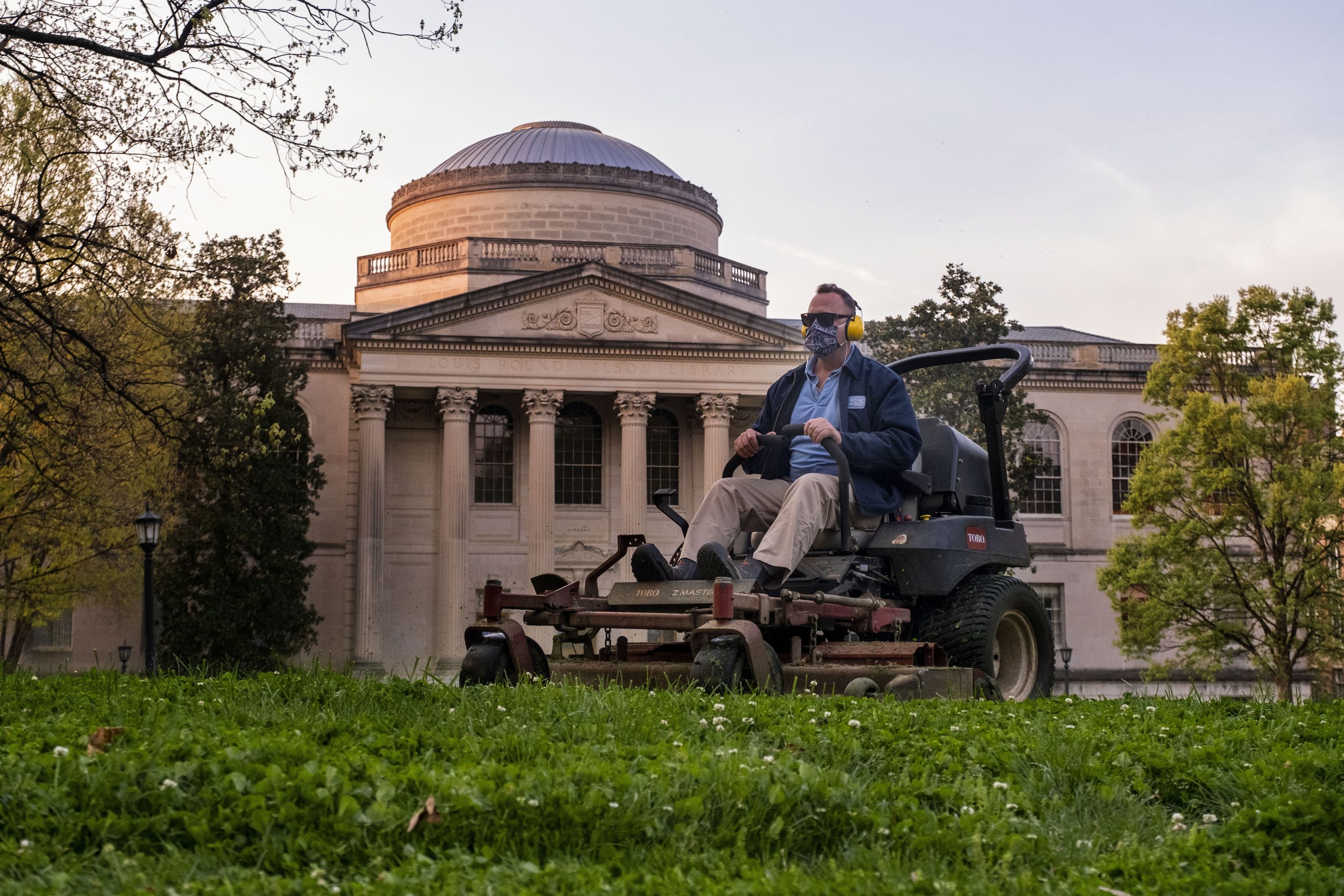
Eric Tolar cuts grass on Polk Place in front of Wilson Library. When few people were on campus from March into summer, Tolar and his crewmates took care of 81 acres of the University’s most visible outdoor areas. “The number one thing we’ve been about is being safe,” Tolar said. “I’ve felt fortunate to be at work at times when the news is 24/7 and can bring you down. We were outside and able to take our minds off of it. And, we could see that people were here at times.” (Photo by Jon Gardiner/UNC-Chapel Hill)
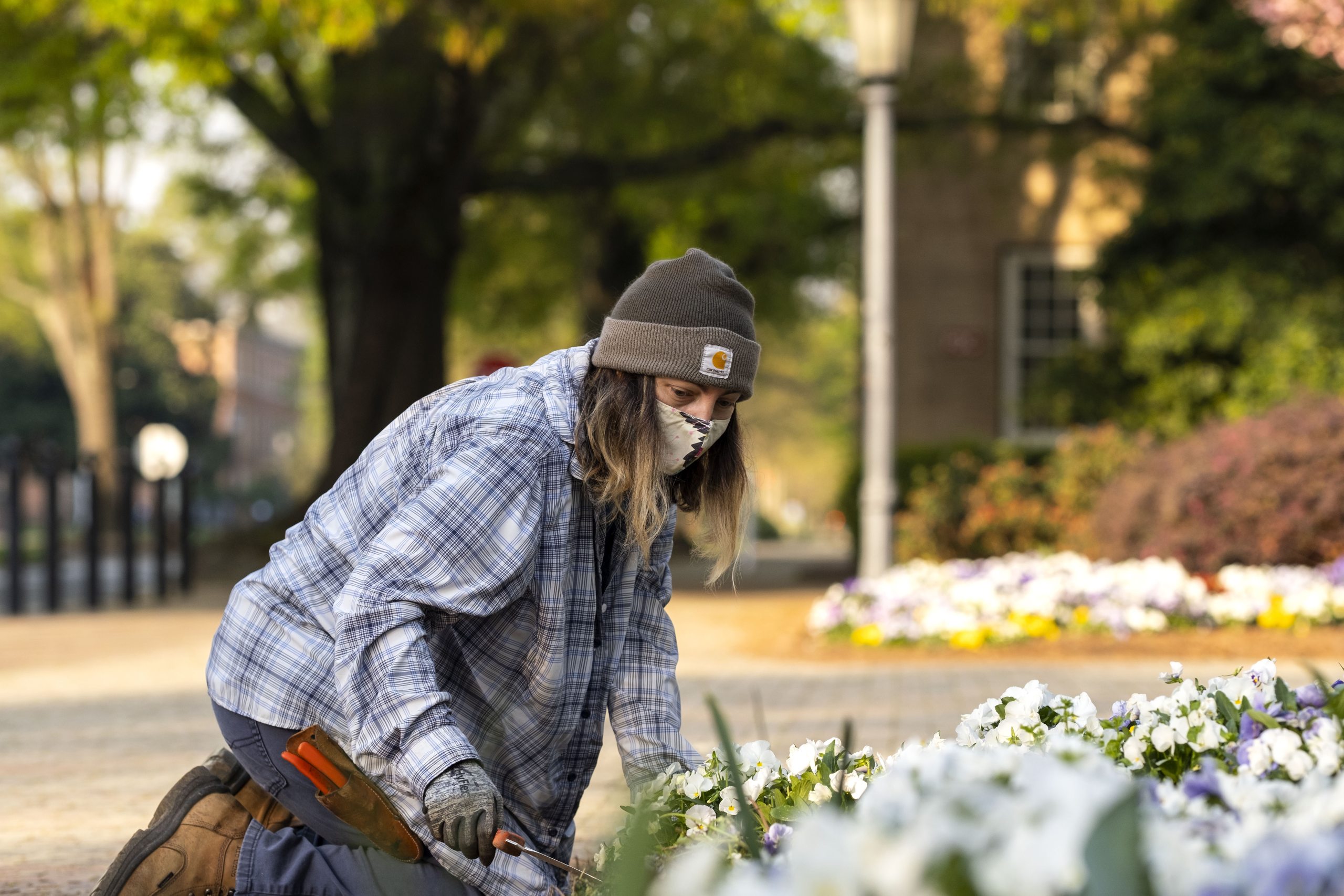
Krystal King works in a flowerbed near the Old Well. The usual planting of annuals and perennials that makes Carolina one of the most beautiful campuses carried on, thanks to King and her co-workers who worked on campus throughout the pandemic. “It’s felt like there’s not enough time to get it all done,” King said. (Photo by Jon Gardiner/UNC-Chapel Hill)

Ryan Talley collects another trash bag from one of the 60 trash cans that the four-person crew emptied twice daily during the time when they were the only groundskeepers working on the historic campus. With the Pit a ghost town, Talley said that the Old Well area became more of a public park where people would eat lunch. The unfortunate byproduct was more trash than normal. (Photo by Jon Gardiner/UNC-Chapel Hill)
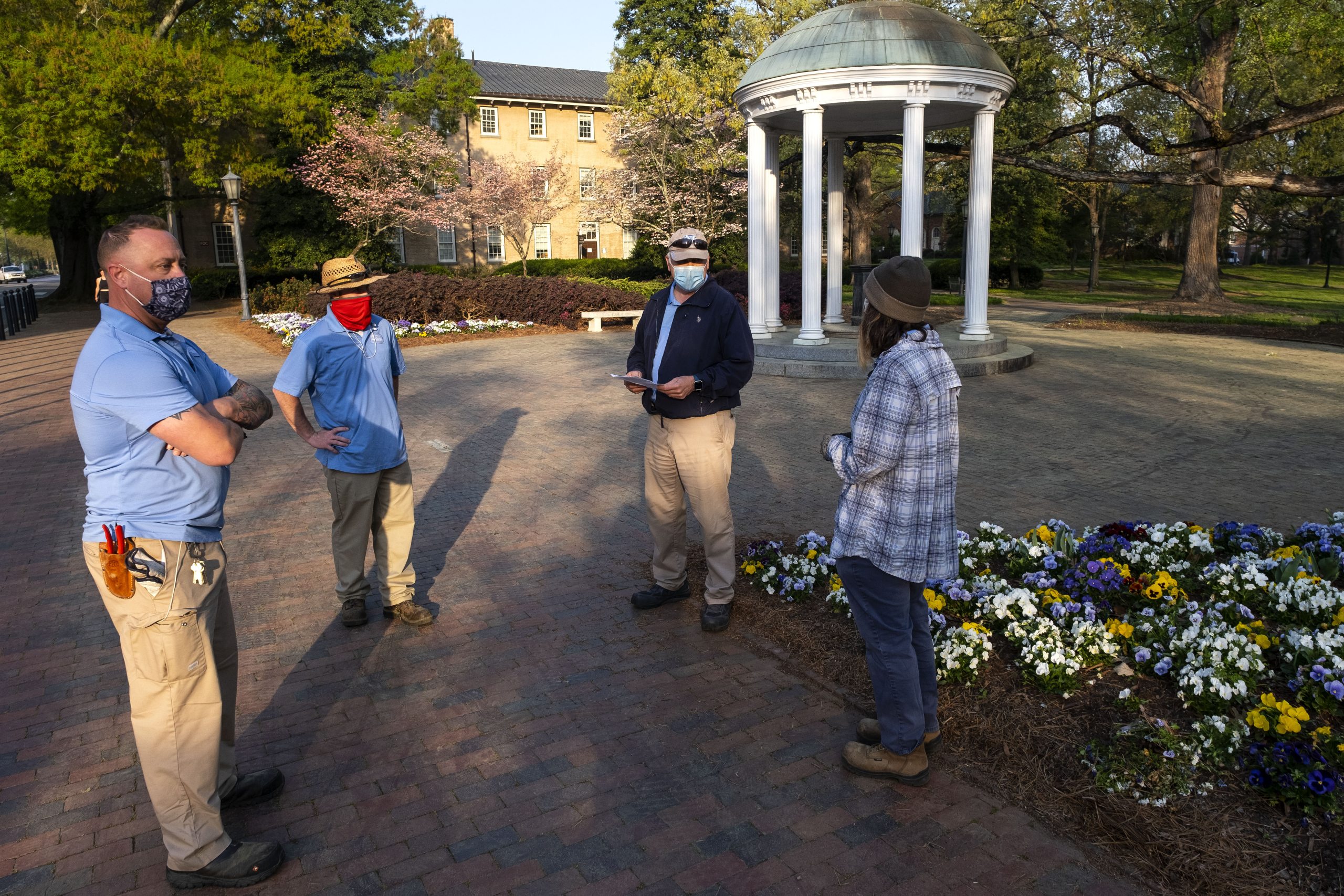
Peter Ampuja, second from right, checks in with the three crew members, left to right, Eric Tolar, Ryan Talley and Krystal King. They had similar meetings at 7 a.m. every day while they were the only groundskeepers working in the historic campus area. “During the pandemic the pace of the life changed but the beauty of campus didn’t,” Ampuja said. “We continued providing a place for the community to enjoy, and campus visitors appreciate the hard work that Grounds crews put in this past spring. It was nice to have people sometimes stop to say ‘thank you’ to the crew.” (Photo by Jon Gardiner/UNC-Chapel Hill)


